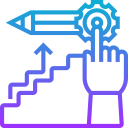Set Your Mentorship Intentions
Choose outcomes you can measure: stronger case studies, improved presentation skills, or stepping into senior responsibilities. Studies consistently link clear goals and effective mentorship with better retention, faster promotions, and deeper creative confidence over time.
Set Your Mentorship Intentions
Draft a simple one-pager: what you want to learn, why it matters now, your constraints, preferred cadence, and example projects. This brief becomes your shared compass, saving time and aligning expectations from day one.
Set Your Mentorship Intentions
Create a weekly growth ritual: a short reflection using the STAR method, a skills matrix update, and one specific question for your mentor. Small, consistent check-ins compound into big, visible progress others can recognize.



